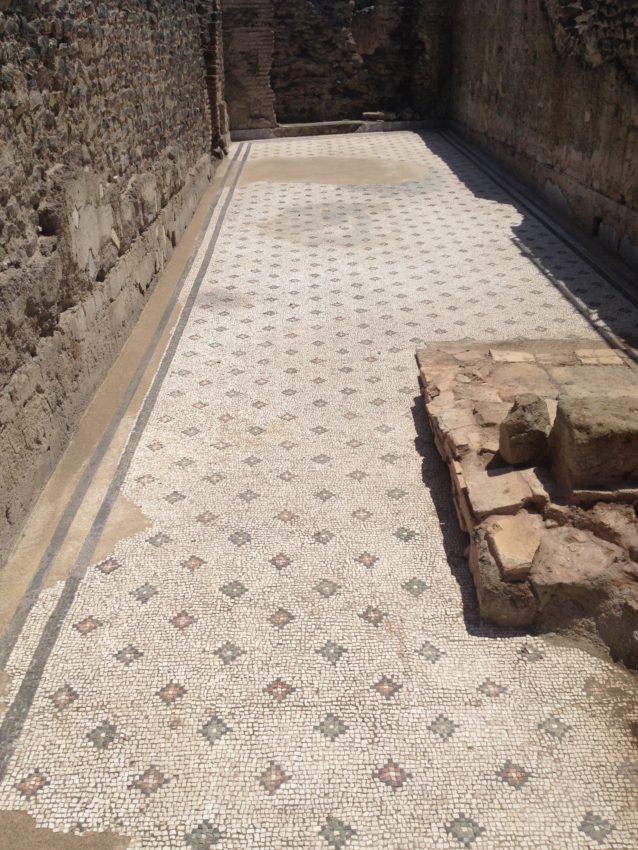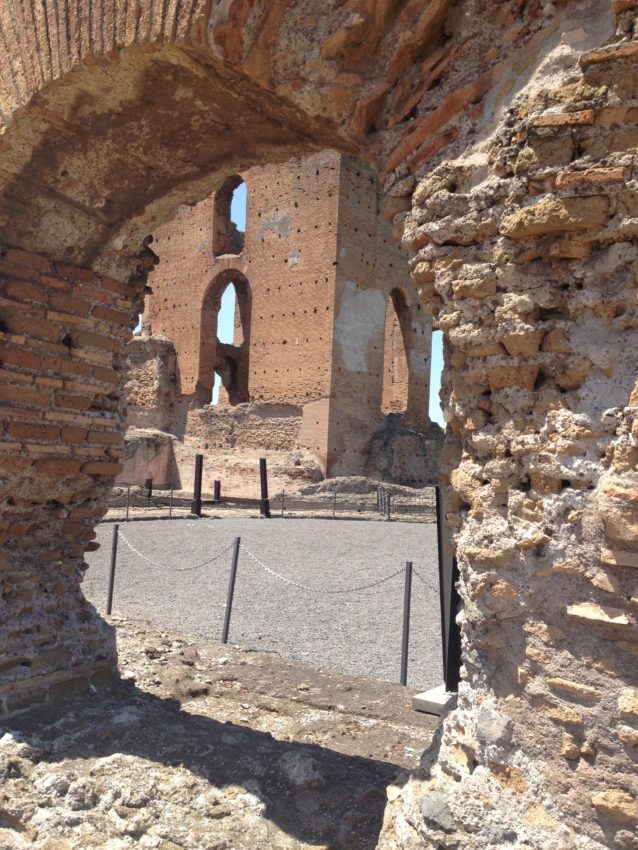Retired in Rome Journal: Walk along Appian Way is a walk in the footsteps of Spartacus and death





What do you think is the most agonizing way to die? Burning alive? That would hurt. Starving to death? That would take the longest. How about living in Nebraska? (Sorry. Sometimes I can’t help myself.) Nope. None of them are as horrific as what I learned and what I walked by in somewhat of a ghostly manner the other day.
Crucifixion.
Getting nailed to a cross is said by some to be among the most painful ways to go. It didn’t get this reputation just because the alleged savior of mankind died this way. Physiologically, it’s like your body explodes inside your skin. When your arms are stretched with nails through the pulses of your hands and a 17-inch spike is drilled into both feet, you are suspended with nothing to hold up your body but the nails. Your bones are dropping. Slowly, ever so slowly, it becomes harder to breathe. You are suffocating. It does not happen fast. Try struggling to breathe for 10-12 hours. That’s how long it takes to die.
By Hour Five you’ll be begging to be covered in black pitch and set afire.
On Sunday I took a hike along the Appia Antica (Appian Way), the same road where Spartacus’ 5,000 fellow slaves (See: Labor Revolts That End Badly) were crucified in 75 B.C. Where I walked a slave once hanged every 500 meters. Today, Appia Antica is one of the most exclusive roads in Rome. Some of the same stones Spartacus and his men marched on are now lined with private villas and covered in shade by lovely, majestic Mediterranean pine trees. I peeked between one of the villas’ many tall “Fuck You!” fences and saw a man in what looked liked $500 shoes polishing his expensive car.
It was all part of the latest Rome Explorers Meetup tour. One of the best ways to live in Rome is to understand Rome, and Rome Explorers has taken me to depths of this city’s 3,000-year history I never knew existed. That is primarily thanks to uber guide Massimiliano Francia (guideromax@virgilio.it), who has gone from a Roman archaeologist to one of the best tour guides in the world. Through 92 countries, he’s the best I ever had.
I knew quite a bit about Appia Antica already. During my first stint here from 2001-03, I spent two months in Rome’s gladiator school. Yes, it has one. And it’s on Appia Antica. I learned to train and fight like real gladiators using real weapons (the points were soldered) in real colosseums. The school holds staged fights in various venues around Italy. You know those Civil War battle reenactments they have back East? The gladiator school’s are like that.
It started out as a magazine story and it turned into a mild hobby that one publication labeled “Men Behaving Madly.” I once died in front of about 1,000 tourists and curious Italians in a small colosseum in Sutri, outside Rome. The biggest challenge wasn’t learning how to defend myself against a 15-pound ax. It was pretending to lie dead while keeping the school’s one-size-fits-all tunic from creeping up and over my underwear.
On one of those sunny spring Rome days in the mid-70s you read about in romance novels, “Max” met Rome Explorers’ two energetic organizers, Laura and Esther, and ex-pats from Venezuela, Holland and Denver. We met at the Basilica Saint Sabastiano, a 17th century reconstruction of a 4th century church that was the first in Rome to have catacombs, a series of tunnels which were safe havens during the persecution of Christians from 258 A.D. This honeycomb of tunnels, built here because Roman law forbade burial grounds within the city walls, meanders under this area for seven kilometers and once held 65,000 tombs.
I’ve toured the catacombs twice. I’ve biked and walked up and down Appia Antica a couple times. But never have I had a guide like Max fill in gaps about my knowledge of Spartacus with fascinating kernels of information. Such as:
* Spartacus was a member of the Thracian tribe from what is now the border area between Macedonia and Bulgaria. He was a Roman soldier and deserted over Rome’s treatment of other peoples. He was captured and turned into a gladiator before escaping again. Good thing Spartacus was a valued gladiator. Romans usually executed deserters by having elephants crush their heads.
* Spartacus’ striking slaves, a mass of 70,000 men, defeated armies for two years. The Roman senator, Gaius Crassus Longinus, believed to be the richest men in Rome with the equivalent of $170 billion (at least enough to help plot the murder of Julius Caesar), recruited men from the Roman army to hunt down Spartacus. Cassius’ army saw Spartacus on a hill near Naples — and ran.
* After finally defeating Spartacus’ army in what is now Basilicata, between Naples and Calabria (the toe of Italy’s boot), Spartacus’ body was never found. Roman soldiers approached the other slaves demanding to know where he was. In loyalty to their leader, each one, hanging from a cross, responded, “I am Spartacus.”
* A prize for the soldiers was taking the clothes slaves wore during their crucifixion. Soldiers would break the slaves’ legs on the cross to speed up the death.
Appia Antica was the most important road in the entire Roman Republic. Built in 312 B.C., it connected Rome with what is now Brindisi on the Adriatic Coast. Rome wanted a direct connection to Greece, its predecessor as the world’s biggest bad guy. The Romans thought the contact would bring in more money and more slaves. It’s why much of the architectural relics you see around Rome today are Greek in origin.
Many of the stones we walked over were the same ones used when Appia Antica was built. Made from volcanic rock found all over the ground, they stand out much larger than the smaller square stones that were put in place in the 1920s as reinforcements.
Atmosphere along the Appia Antica today best represents the most popular word in the beautiful Italian language: passaggiata. It means “stroll.” Italians love to stroll. They do it after meals (See: Reason No. 150 Why Italians Are Thinner Than Americans) and especially on Sundays. We toured on a Sunday. Rome closed the narrow part of the Appian Way to traffic in the late 1960s when the traffic jams became too much, leaving us with one of the most beautiful walking malls in the world. Just a few miles from the teeming mobs around the Colosseum, where tourists posed for pictures with fake Praetorian guards, we walked in the footsteps of the Roman army in the shade of Mediterranean pines. Occasionally, we’d see couples walking hand in hand. Cyclists on slow, rented bikes would cruise by, bopping up and down on the cobblestones. Joggers actually seemed like they were smiling. Birds chirped in the pines. Not a car engine could be heard. I imagined myself back in Ancient Rome, sitting outside my villa, enjoying a cluster of grapes, my horses feeding in a nearby stable.
And hearing the screams of slaves dying on crosses outside my door.
But enough romance …
We soon came to a huge empty field. It was about 200 meters long and 100 meters wide. So well kept, it looked manicured, like a sports field ready to be lined with chalk. This was one of the sites for chariot races. Called Circo Maxentius, it was built in 311 A.D. and still has the remains of eight stone blocks which the chariots stood between before the start. Also visible are two towers where referees stood and some remains of the stands.
This is how chariot races worked: Four chariots were pulled by four horses each. When the emperor dropped a white napkin, the gates opened and the horses flew out. They raced seven laps or about 4,800 yards. Four chariots were pulled by four horses each. Only the two middle horses were tied to the chariot. To make smoother left-hand turns — Max did not make this up — they made sure the far left horse was a male in heat. That way he would make the left-hand turns as fast as possible to follow the female horse on the far inside left. (If you want to see a reenactment, watch Italian men around the Spanish Steps on a Friday night.)
The Circo Massimo in central Rome held 300,000 spectators. This one held 10,000. Alas, it was never used. Built by Emperor Maxentius, he died before about the time of his completion and the time when he was the last emperor of Rome. Today it is left for wandering visitors strolling by on a passaggiata.
On our way back, we stopped by the remains of one of the emperor’s palaces. Set off from the road and behind a museum holding Roman artifacts, it’s a sprawling complex sitting atop a small hill. Two-story buildings have openings where huge doors once stood. This complex once held three pools. The Ancient Romans’ method of therapeutic bathing was to soak in a hot pool first, a tepid pool second and a cold pool third. The foundations of the pools remain, not far from living quarters lined with Third Century mosaics. Black and white birds flew in and out of the ruins. A cool breeze drifted up the Tyrrhenian Sea. Never has a cheese sandwich in foccacia bread tasted so good.
The Roman Army had some heart. They gave the slaves a great place to die.

